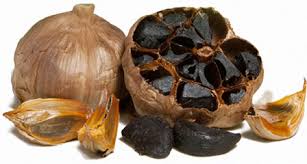A member of the allium family, which also includes onions and chives, garlic has been used in Britain since at least the beginning of the sixteenth century. The main beneficial ingredients of alliums are allicin and diallyl sulphides, which are anti-bacterial and anti-fungal. Garlic is believed to promote health by aiding the circulatory and digestive systems, boosting the immune system and lowering blood pressure. It also eliminates toxins and regulates blood sugar levels. The antibiotic quality of the plant means it can be used to treat colds and coughs and, if you can find a recipe, Athlete's Foot.
Garlic has more recently come under scrutiny for its anti-cancer properties, as a diet rich in garlic may reduce the likelihood of stomach cancers, as well as breast and prostrate cancers.
late February to March will do in the UK. Plant the cloves from a bulb, with the sharp end upwards, in full sun and in well drained soil, 2cms deep and 15 cms apart. Keep well watered. They will mature in the summer, when the top growth begins to change colour and keel over. Dry the bulbs thoroughly in the sun. Some folk believe tying the stems in a knot while the garlic is growing will increase the size of the bulb. I haven't tried this, so I can't confirm it. You can plant another batch in the autumn, but will have to protect it if the temperature falls below -15 degrees C, or 5 degrees F.
If you haven't got a garden plot, you can grow garlic in a container, on a sunny window sill, which will enable you to harvest the green leaves in much the same way you would chives.
It can be used as a companion plant as it masks the smell of the plants it is near. It is also, when used with water, is supposed to get rid of white fly. I have used it, but found no real impact on the pest. In my opinion, nothing really works on whitefly. Apparently, you can also use garlic as a glue and to neutralize bites and sting, but probably not at the same time.
The stalks of the immature flowers, or Garlic Scapes, can be harvested in late spring or early summer and added to salads. They have the same benefits as the bulb, but with a milder taste.
Cooked garlic doesn't have the same levels of allicin as raw, though it does retain other compounds. It is recommended that you let the garlic stand for 10 minutes after crushing it to allow the allicin to develop, before heating. If you want to keep its benefits, don't microwave it!
Something I did come across while researching this, is Black Garlic- apparently
aged garlic, which, I am led to believe, has a "treacly balsamic flavour", and twice the anti-oxidants as white garlic, and without the smelly breath. Let us know if you've tried it.



No comments:
Post a Comment